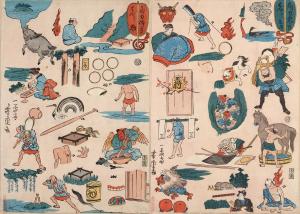Picture Puzzle for Sumo on the East, Picture Puzzle for Sumo on the West (Sumō Higashi no Kata Hanjimono, Sumō Nishi no Kata Hanjimono)
Painted by Utagawa Yoshitora 1859 (Ansei 6) Tokyo Shiryō Collection 447-C6-1,2
This picture puzzle (hanji-mono) depicts popular sumo wrestlers and referees on both the east and the west and challenges one to guess their names. A picture puzzle is one of the games to guess the hidden meanings of letters and pictures.
A riddle called "Monozukushi Hanjimono (picture puzzles)" was popular from the late Edo period till the last days of the Tokugawa shogunate. This is similar to a quiz in which one looks at the pictures and guesses what they represent.
Let's look at the picture puzzle here. The names of thirteen sumō wrestlers on the "East" and fourteen wrestlers on the "West" are hidden in the picture. Some of the names have been passed down up to the present or remain as a master's name. A picture puzzle like this implies that sumō was very popular in those days.
Here is an example of the puzzle. At the bottom in the centeral part of the picture of sumō wrestlers on the "East", we can find a tree ("ki" in Japanese"), village ("mura"), a reed pipe used for the court music of Japan ("shō"), field ("no") and the statue of upper body of "Sukeroku", which is a famous role in kabuki. When we combine the names of these five pictures, the name of sumō referee "Kimura Shōnosuke" comes


